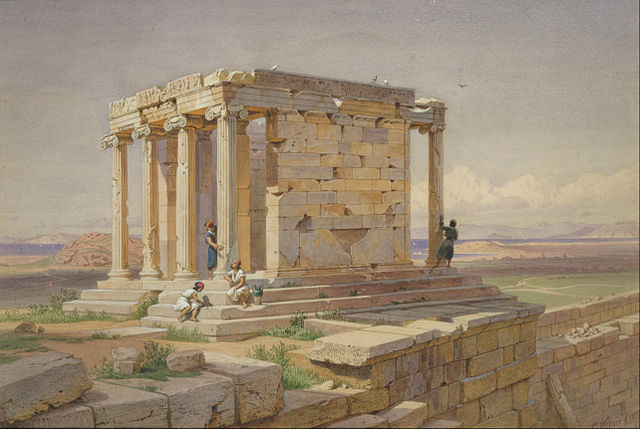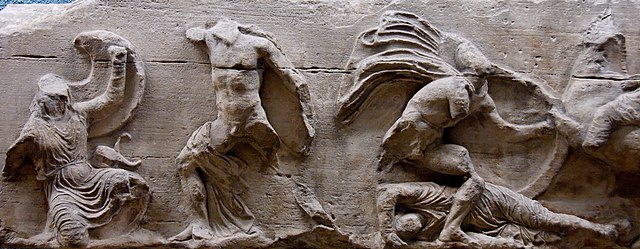The Temple of Athena Nike is a temple on the Acropolis of Athens, dedicated to the goddesses Athena and Nike. Built around 420 BCE, the temple is the earliest fully Ionic temple on the Acropolis. It has a prominent position on a steep bastion at the south west corner of the Acropolis to the right of the entrance, the Propylaea. In contrast to the Acropolis proper, a walled sanctuary entered through the Propylaea, the Victory Sanctuary was open, entered from the Propylaea's southwest wing and from a narrow stair on the north. The sheer walls of its bastion were protected on the north, west, and south by the Nike Parapet, named for its frieze of Nikai celebrating victory and sacrificing to their patroness, Athena and Nike.
The Temple of Athena Nike
Painting of the Temple of Athena Nike, by Carl Werner, 1877
Scene of the Battle of Plataea, from the south frieze of the Temple of Athena Nike, British Museum (London)
Temple of Athena Nike is on the right from the Propylaea
The Acropolis of Athens is an ancient citadel located on a rocky outcrop above the city of Athens, Greece, and contains the remains of several ancient buildings of great architectural and historical significance, the most famous being the Parthenon. The word Acropolis is from the Greek words ἄκρον and πόλις. The term acropolis is generic and there are many other acropoleis in Greece. During ancient times the Acropolis of Athens was also more properly known as Cecropia, after the legendary serpent-man Cecrops, the supposed first Athenian king.
The Acropolis of Athens, seen from Philopappos Hill
The Acropolis of Athens as seen from Mount Lycabettus The wooded Hill of the Nymphs is half-visible on its right, and Philopappos Hill on the left, immediately behind. The Philopappos Monument is seen here where, in the distant background, the coast of Peloponnese meets the waters of the Saronic Gulf.
Primitive Acropolis with the Pelargicon and the Old Temple of Athena.
Elevation view of a proposed reconstruction of the Old Temple of Athena. Built around 525 BC, it stood between the Parthenon and the Erechtheum. Fragments of the sculptures in its pediments are in the Acropolis Museum.







